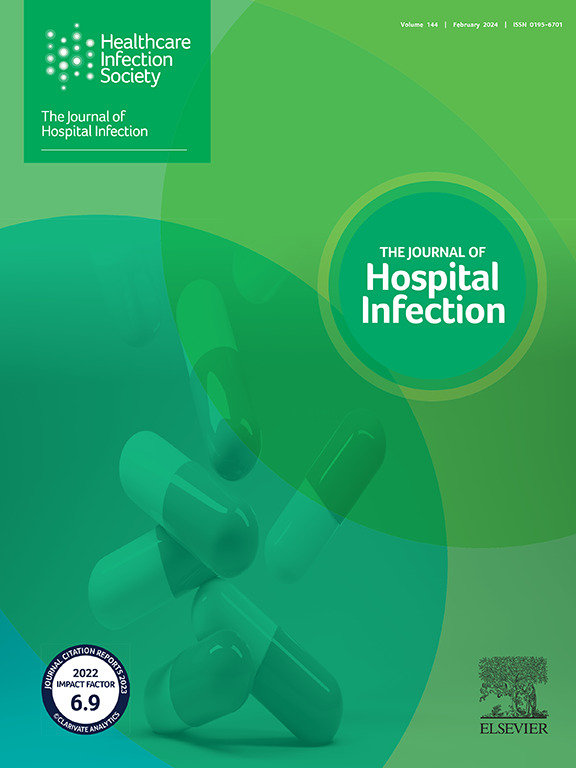使用包裹 DNA 的二氧化硅纳米粒子模拟新生儿病房的疫情--揭示关键传播区域。
IF 3.9
3区 医学
Q1 INFECTIOUS DISEASES
引用次数: 0
摘要
目的:非医院感染构成严重威胁。特别是在新生儿重症监护室(NICU),微生物导致的爆发事件屡屡发生,但其来源或动态却无法确定。本研究旨在使用封装了 DNA 的无定形二氧化硅纳米粒子(SPED)来模拟疫情爆发事件,并对新生儿重症监护室中的传播模式进行可视化,从而更好地了解这些动态:在病房中战略性地放置了三种类型的 SPED,以模拟真实环境和员工活动中三种不同的传播动态。在整个病房的 22 个预定点进行了为期四天的 SPED DNA(对消毒剂有抗药性)采样,并进行了 qPCR 分析:结果:从员工区开始,SPED 迅速扩散到整个病房,包括许多病房。与此形成对比的是,在病房中的主要部署只导致了在员工区的传播,而没有在病人区传播:这项研究开创了利用 SPED 模拟疫情动态的先河。所揭示的模式揭示了员工区作为全院传播的潜在关键触发点,有助于更全面地了解疫情爆发事件,从而重新思考卫生措施和培训,降低医院的非医院感染率。本文章由计算机程序翻译,如有差异,请以英文原文为准。
Outbreak simulation on the neonatal ward using silica nanoparticles with encapsulated DNA: unmasking of key spread areas
Background
Nosocomial infections pose a serious threat. In neonatal intensive care units (NICUs) especially, there are repeated outbreaks caused by micro-organisms without the sources or dynamics being conclusively determined.
Aim
To use amorphous silica nanoparticles with encapsulated DNA (SPED) to simulate outbreak events and to visualize dissemination patterns in a NICU to gain a better understanding of these dynamics.
Methods
Three types of SPED were strategically placed on the ward to mimic three different dissemination dynamics among real-life conditions and employee activities. SPED DNA, resistant to disinfectants, was sampled at 22 predefined points across the ward for four days and quantitative polymerase chain reaction analysis was conducted.
Findings
Starting from staff areas, a rapid ward-wide SPED dissemination including numerous patient rooms was demonstrated. In contrast, a primary deployment in a patient room only led to the spread in the staff area, with no distribution in the patient area.
Conclusion
This study pioneers SPED utilization in simulating outbreak dynamics. By unmasking staff areas as potential key trigger spots for ward-wide dissemination the revealed patterns could contribute to a more comprehensive view of outbreak events leading to rethinking of hygiene measures and training to reduce the rate of nosocomial infections in hospitals.
求助全文
通过发布文献求助,成功后即可免费获取论文全文。
去求助
来源期刊

Journal of Hospital Infection
医学-传染病学
CiteScore
12.70
自引率
5.80%
发文量
271
审稿时长
19 days
期刊介绍:
The Journal of Hospital Infection is the editorially independent scientific publication of the Healthcare Infection Society. The aim of the Journal is to publish high quality research and information relating to infection prevention and control that is relevant to an international audience.
The Journal welcomes submissions that relate to all aspects of infection prevention and control in healthcare settings. This includes submissions that:
provide new insight into the epidemiology, surveillance, or prevention and control of healthcare-associated infections and antimicrobial resistance in healthcare settings;
provide new insight into cleaning, disinfection and decontamination;
provide new insight into the design of healthcare premises;
describe novel aspects of outbreaks of infection;
throw light on techniques for effective antimicrobial stewardship;
describe novel techniques (laboratory-based or point of care) for the detection of infection or antimicrobial resistance in the healthcare setting, particularly if these can be used to facilitate infection prevention and control;
improve understanding of the motivations of safe healthcare behaviour, or describe techniques for achieving behavioural and cultural change;
improve understanding of the use of IT systems in infection surveillance and prevention and control.
 求助内容:
求助内容: 应助结果提醒方式:
应助结果提醒方式:


